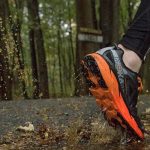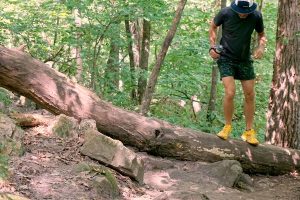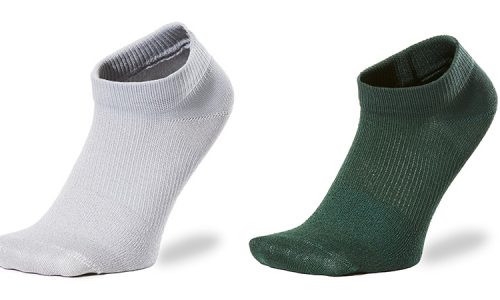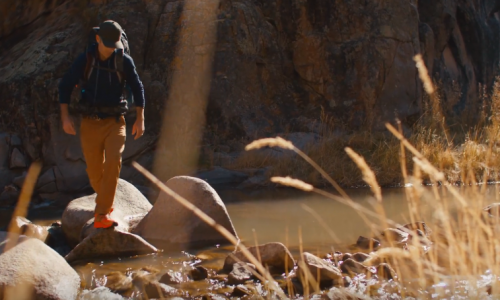Home » Gear Reviews » Running » Running Shoes » Trail Running Shoes » Cushioned & Protective Trail Running Shoes » Altra Lone Peak 4.0
Altra Lone Peak 4.0 Review
September 29, 2016















 84
84 The Good
- Grippy outsole
- Wide toe box
- Aggressive tread
- Great drainage
- Multiple versions
The Bad
- Zero-drop adjustment
- Weak heel cup
- Unresponsive ride
- Bulky stitched uppers
The Altra Lone Peak comes in four different versions: the standard low-top mesh model (tested and reviewed here), a mid-top mesh model with an extended supportive ankle collar, a low-top waterproof version with Altra’s new RSM (Rain Snow Mud) treatment, and a mid-top RSM version. All four version have the same midsole and outsole, which has a 25mm rear stack height and 25mm forefoot stack height (0mm heel-to-toe drop). Likewise, all four versions are built with Altra’s well-known wide, foot-shaped front end, which gives toes room to splay. While Altra’s trail line expands into more niche models like the King MT 1.5 and Timp, the Lone Peak 4.0 stays the course as the balanced middle-ground between the minimalist Superior 3.5 and the max-cushion Olympus 3.0. The Altra Lone Peak 4.0’s uppers are a densely-woven mesh, which offers some water resistance even without the waterproof RSM treatment.
The standard low-top mesh Altra Lone Peak 4.0 is nimble on the trail, thanks to the zero-drop platform. Runners who have made the transition to zero-drop or are already running in shoes with low heel-to-toe drop will find a lot to like in the Altra Lone Peak 4.0’s platform. The 25mm stack height is deep enough to be protective, but not so thick that it feels separated from the trail (a complaint some of our wear-testers had about the max-cushion Olympus 3.0, which has a 33mm stack height). The runners on our crew also appreciated the wide forefoot. Some had concerns that the fit would feel sloppy or loose, but Altra has the fit dialed in and most runners should find the fit pretty secure.
Most of the support framework on the upper is stitched rather than heat-bonded to the mesh, which adds unnecessary weight, bulk, and points of irritation. Fewer and fewer trail running shoes still use stitched-on overlays, and it increasingly feels like an outdated design concept. Our wear-test runners were also generally unimpressed by the responsiveness of the midsole, which is made from an uninspired EVA foam. Those who have run in Altra models that use the company’s proprietary Ego foam know that Altra has the technology for a responsive, lively ride. Updating the Altra Lone Peak line from EVA to Ego foam would be a substantial improvement. The Altra King MT 1.5 has an Ego foam midsole, and even though it has a stiff rockplate and lower stack height (19mm front/rear), it feels more responsive on the trail than the Altra Lone Peak 4.0 (the King MT also uses heat-bonded TPU overlays instead of stitched-on, so maybe there are multiple cues the Altra Lone Peak line could take from that model). Between the flat-feeling midsole foam and the bulky stitched-on overlays, Altra’s flagship trail shoe feels more and more dated, and our wear-testers think it’s ready for a ground-up revamp.
Comfort
One of our wear-testers called the Altra Lone Peak 4.0 “one of the most comfortable (and best looking) shoes I’ve tested.” The updated Altra Lone Peak keeps the dense mesh uppers of the previous version, but uses a different weave. The revamped uppers now use a mesh with cross-hatching threads that remind our wear-testers of the Salomon Speedcross 4 uppers, which are soft and notoriously durable. The new mesh also allows Altra to drop some of the stitched-on toe box overlays, which shaves a bit of weight and eliminates potential points of irritation. The tongue and heel collar are lightly padded, with more built-in cushion than the Altra King MT 1.5 and less than the highly-cushioned Olympus 3.0. Our wear-testers were also impressed at how soft and cushioned the insole and midsole feel right out of the box.
Speed
The Altra Lone Peak 4.0 has a 25mm stack for the heel and forefoot (0mm heel-to-toe drop), which makes it feel relatively minimalist on the trail. As one of our wear-testers noted, however, “the weight is anything but minimalist. I have a hard time putting that label on a shoe that weighs over ten ounces” (the Lone Peak 4.0 weighs 10.6oz for men’s size 9). The overall weight and looser front end (thanks to Altra’s wide, forefoot-shaped toe box) kept the Altra Lone Peak 4.0 from feeling terribly fast or nimble on the trails. Our wear-testers didn’t describe it as sluggish or clunky either, thanks in part to a rockered midfoot that helps the Altra Lone Peak 4.0 have quick turnover through the stride and toe-off. However, as one of our wear-test runners put it, “this is really only a shoe I’d use for long, slow runs where I’m watching the scenery, not watching the finish line clock.”
Security of Fit
Our wear-testers were split on the Altra Lone Peak 4.0’s wide toe box. Fans of Altra’s foot-shaped construction appreciated how it allowed their toes to splay. As one put it, “I forget how constrictive other shoes feel until I put one on right after running in a pair of Altras. The difference is impossible to miss.” Other runners on our wear-test team though the Altra Lone Peak 4.0’s overall fit was loose and sloppy, however (even when they wore their correct size and the length was correct). As one reported, “typical Altra fit with the flared toe box, which made the shoe fit rather loose. Fine for easy runs, however once I wanted to pick up the pace, the shoe felt sloppy.” A runner on our wear-test crew also noted, “the entire shoe was soft, which made it super comfortable, but also contributed to the sloppy fit. No heel counter, which made the back end feel flimsy.” Our wear-testers also noted that the stitched-on overlays feel bulky and dated in an era where more and more trail shoes are built with reinforced mesh or heat-bonded, stichless overlays. Runners looking for a more secure fit through the ankle may want to check out the mid-top version of the Altra Lone Peak 4.0, which comes in standard mesh and a waterproof RSM (Rain Snow Mud) version.
Agility
The most significant change between the Altra Lone Peak 3.5 and 4.0 is the design of the outsole. The new Lone Peak 4.0 gets a new proprietary MaxTrac rubber and big changes to the lug shapes. Where the Altra Lone Peak 3.5 had hexagonal lugs across the forefoot and simple triangles under the heel, the revamped outsole on the Altra Lone Peak 4.0 has a series of chevron-shaped lugs in both spots. The forefoot chevrons are rear-facing for traction on uphills, while the heel chevrons are forward-facing for extra grip and stability on descents. Our wear-testers who have experience in both models noted this as a big, positive update. Although the lugs are still only 4-5mm deep (compared to the massive 8mm lugs on the Altra King MT 1.5 or Salomon Speedcross 4), the design and orientation helps the Lone Peak 4.0 have excellent traction on a variety of trails and surfaces. As one wear-tester put it, “I hit every kind of trail in the area and felt like I could run confidently on all of them. The Altra Lone Peak didn’t hold me back.”
Responsiveness
The Altra Lone Peak 4.0 uses the same midsole as the previous versions, which has a 25mm front and rear stack height and a combination foam made from EVA and Altra’s proprietary A-Bound material. According to Altra, the A-Bound material is firmer with less compression than traditional EVA foam, and it’s made from recycled materials. The Altra Lone Peak 4.0 uses A-Bound as a layer in the top half of the midsole. As one of our wear-testers reported, “the Altra Lone Peak’s midsole feels soft at impact, but firm enough for a stable push-off. It’s a good combination!” Another wear-tester, however, was looking for more firmness out of the midsole. As he put it, “the midsole has the same soft feeling as the rest of the shoe. I weigh 140 and I felt like it was bottoming out.”
Protection
The Altra Lone Peak 4.0 builds in more protective features than most trail running shoes, including integrated 4-point gaiter hooks, a flexible midsole StoneGuard, drainage ports in the toe box. Although the Altra Lone Peak 4.0 has a rockplate embedded in the midsole, one our wear-testers reported that he could feel rocks and sharp trail obstacles through the bottom of the shoe. While he liked the shoe overall, he concluded, “it just needs to be used in correct terrain. This would be a go-to shoe for slow running on easy terrain.” Runners who like the fit and features of the Altra Lone Peak 4.0 but want additional protection should be able to find it in the low-top and mid-top versions with proprietary RSM (Rain Snow Mud) treatment. Altra has offered a water-resistant version of the Lone Peak in the past, but this is the first version to move away from Polartec Neoshell treatment and into a proprietary technology. One wear-tester who had the chance to try on both reports that the RSM version fits slightly smaller than the standard mesh version.
Jason is a trail runner and ultra-marathoner who lives with his wife and children in the frozen tundra of northeastern Wisconsin.




















